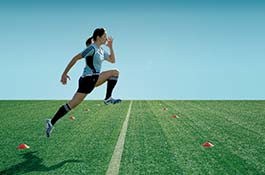Strength and Conditioning
Original Editor - Oyemi Sillo
Top Contributors - Naomi O'Reilly, Kim Jackson, Lucinda hampton, Oyemi Sillo, Vandana Tanwar and WikiSysop
Introduction[edit | edit source]
Strength and Conditioning (S&C) is the selection and development of dynamic /static exercises used to improve physical performance. Whilst it originally benefited athletes it is now widely used in both the sporting world and more generally.
- S&C is used to develop every area of the body and improve the way a person moves, with the intention of enhancing sporting or physical performance.
- Research demonstrates that correct and appropriate training can improve physical performance. It also shows that incorrect and inappropriate training can be very detrimental to the way the body moves and performs, whether that’s in daily life eg walking the dog, or at hobby or sport[1].
- Strength and Conditioning training involves a wide range of exercises developed to build a variety of skills with a focus on mind, mobility, stability, strength, endurance, power, speed, agility and performance.
- Combines strength training, aerobic conditioning, speed and agility training, as well as sport-specific training.[2]
- Aims to improve strength and endurance, reduce the incidence and severity of sport injuries, and to improve technique and overall performance.
- Beneficial for people of different ages and abilities eg can help older people maintain and improve their health and quality of life.[3]
Principles of Strength and Conditioning[4][5][edit | edit source]
S&C means engaging in activity to improve performance and/or fitness; this is best accomplished by understanding general seven sports training principles: overload, reversibility, progression, individualization, periodization, and specificity.
- Individuality - People will have unique responses to the same training stimulus, due to individual characteristics such as biological age, training age, gender, body size and shape, past injuries etc. Thus, training should be adjusted to the individual’s characteristics and needs.
- Specificity - Physiological adaptations to training are specific to the muscle groups trained, the intensity of the exercise, the metabolic demands of the exercise, and specific movements and activities.
- Overload - Certain adaptations require training with greater stimulus than that which the body is accustomed to.This could be done by increasing the intensity, duration, or frequency of training.
- Progression/Periodization - Overloading should occur at an optimal level and time frame to maximize performance. Overloading too quickly may lead to poor technique or injury, while very slow overloading may result in little or no improvements.
- Diminishing Returns/Adaptation - An individual’s level of training determines how much improvements in performance they achieve due to training. A novice will see huge and relatively quick gains in performance when they begin training, however, the gains get smaller and come more slowly as they get more experienced.
- Reversibility - The effects of training will be lost if training stimulus is removed for an extended period of time.[4]
Benefits[5][3][edit | edit source]
Proper strength and conditioning allows an athlete to strengthen supporting muscles, even out muscle imbalances, increase mobility, correct posture, stabilize joints, learn new movement patterns and enhance coordination and peripheral skills. Specifically:
• Increases muscle strength.
• Increases muscle endurance.
• Increases muscle fiber size.
•Strengthened Mental Health.
• Increases neural recruitment.
• Improves connective tissue function.
• Improves bone health.
• Improves motor skill and confidence to engage further in physical activity.
• Improves mobility and flexibility.
- General population also gets same benefits if they train under some professional ,and may get best out of their current fitness levels too while minimizing chances of metabolic/cardio vascular disorders.
- Lower Abdominal Fat. ...
- Better Cardiovascular Health. ...
- Controlled Blood Sugar Levels. ...
- Reduced Cancer Risk. ...
- Lowered Injury Risks. ...
- Strengthened Mental Health. ...
- Improved Flexibility and Mobility. ...
- Elevated Body Image.
Resources / References.[edit | edit source]
- ↑ Hatt Strength and Conditioning Available from:https://www.hattclinic.co.uk/what-is-strength-conditioning (accessed 23.3.2021)
- ↑ Cissik JM. Strength and Conditioning: A concise introduction. London: Routledge 2012
- ↑ 3.0 3.1 Haff GG, Triplett NT. Essentials of strength training and conditioning. Champaign: Human Kinetics, 2016
- ↑ 4.0 4.1 Cissik JM. Basic principles of strength training and conditioning. NSCA’s Performance Training Journal.2002:1(4), 7-11.
- ↑ 5.0 5.1 Murray TD, Eldridge J, Kohl HW. Foundations of Kinesiology: A Modern Integrated Approach. Boston: Cengage Learning, 2018








